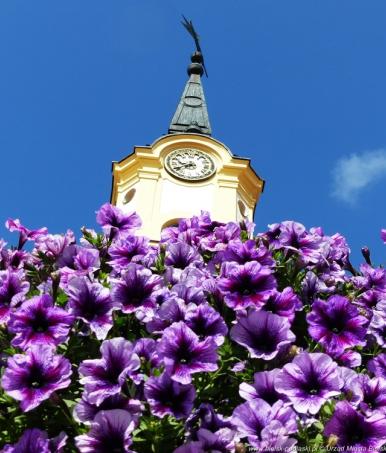Font size
Wybór języka
History
Content
A chronology of the most important events from the history of the town
1252 – a war with Lithuania. In a description of the war in the Galician-Volhynian Chronicle there is the very first historical record about Bielsk. At that time the town was under the sway of the Russian Prince Vasilko Romanovich, who ruled from Volodymyr-Volynsky. According to a preliminary archaeological survey the town of Bielsk was established in the 12th century, but a settlement near Zamkova Street existed in the 10th century.
1288 – Duke Volodymir (son of Vasilko) dies. The chronicler recorded the donation of icons and liturgical books to an Orthodox church in Bielsk.
1366 – peace treaty between Casimir the Great and Lithuanian dukes stating the appurtenance of Brest, Drohiczyn and Bielsk to the Duchy of Trakai.
1373 – the first ever bloody border raid recorded by chroniclers, carried out by the Teutonic Knights on the towns between the River Bug and the River Narew: Bielsk, Kamieniec, Brest, Mielnik and Drohiczyn. Plundering raids by the Teutonic Knights stopped in 1379, when a peace treaty was signed.
1382 – during the conflict between Kęstutis, his son Vytautas and Jogaila, Janusz the Duke of Masovia, described by Jan Dlugosz as “a prudent and resourceful man, adhering to the principle that everyone should make hay while the sun shines… conquered two castles – Drohiczyn and Mielnik…, ruined the lands of Suraż, Bielsk, Kamieniec and Brest”. A year later Drohiczyn was recaptured by Jogaila, who in 1384 made a donation of this part of the Duchy of Trakai to Vytautas, with whom he reached a compromise. But soon after the Union of Krewo was signed another conflict between Lithuanian dukes arose, and Jogaila gave the southern part of Vytautas’s patrimony, the land of Drohiczyn together with the towns of Drohiczyn, Mielnik, Suraż, and Bielsk, as a fief to Janusz, the Duke of Masovia.
1413 – after the Union of Horodło was signed, when Vytautas was officially recognized as the Grand Duke of Lithuania, the Trakai and the Vilnius districts, the parts of strictly political character, were transformed into administrative units, i.e. Trakai Voivodeship and Vilnius Voivodeship. One of the constituent parts of Trakai Voivodeship was the Drohiczyn district, and Bielsk was a part of this for the whole of the 15th century. With the passing of time Bielsk became the centre of the Bielsk district, which extended to the north to Rajgród and Augustów.
1430 – Vytautas the Great issues a decree allowing Andrzej and his heirs to create the Bielsk aldermanship: “among other things we decided to ameliorate the condition of our little town Bielsk, which is in the Drohiczyn district, by empowering a decisive and resolute alderman to populate the town. (…) It will be within his power to settle in the said town only men and women of the Roman Rite, to wit Poles and Germans beckoned over. Yet it must not be executed to the prejudice and detriment of the Ruthenians who dwell in it.” This document started the process of the reconstruction of Bielsk from “a little town” subordinate to common law and a Starost, an official representatives of the Grand Duke, administering from the castle, to a town with its own legal status and municipality. New settlers were placed in the area of the present location of the Town Hall; here also the parish Church of the Nativity of the Blessed Virgin Mary and St. Nicholas was erected.
1495 – due to the decision of Grand Duke Alexander the town is granted “for perpetuity the Magdeburg Law in its all ampleness and power”. The townsmen of the “New Town”, established after 1430, and the Ruthenians living to the south of the “Old Town” were subject to the new law.
1499 – Grand Duke Alexander extends the powers of the town authorities and reduces townsmen’s levies and charges.
XVI w. – fast development of Bielsk; the town becomes the most populated (about 4 thousand townspeople) and the richest town in the region. In his “A Description of Sarmatian Europe” Alessandro Guagnini writes about Bielsk “… a wooden town, the most exceptional in the Podlasie region”.
1501 – an assembly of “the noble members” of the Lithuanian Council of Lords with the assistance of Grand Duke Alexander takes place in Bielsk, just before entering into the Union of Mielnik, and his ascending the throne as the King of Poland.
– Alexander Jagiellon, King of Poland, confirms Jakub Hoppen in office of the Starost, and the town’s Magdeburg Laws.
1506 – Queen Helena, wife of the deceased Alexander Jagiellon, King of Poland, receives in perpetuity Bielsk castle along with Suraż and Brańsk and in addition to that the proceeds from the goods (this was her widow’s pension granted by the new monarch, Sigismund I the Old) .
1513 – the southern part of Trakai Voivodeship is transformed into a new administrative unit, named Podlasie Voivodeship. At first its territory included Brest, Kamieniec and Kobryn, but in 1566 its eastern part was transformed into a new administrative unit, Brest Voivodeship, while its western lands, mainly the regions of Drohiczyn, Bielsk and Mielnik were still the constituents of Podlasie Voivodeship.
1533 – Queen Bona buys out Bielsk from Albrecht Goštautas. Under the reign of Queen Bona there was a period of development and economic efflorescence in the town.
1562 – Bielsk’s oldest church, the Orthodox Church of the Nativity of the Most Holy Mother of God, is taken from the castle to the Old Town (its present location). At that time there were four other Orthodox Churches in Bielsk – St. Nicolas’, St. Michael’s, The Church of The Lord’s Resurrection, and Holy Trinity Church, and one Roman Catholic Church, that of the Nativity of the Blessed Virgin Mary and St. Nicholas.
1563 – there are 830 houses in the town.
1564 – a convention of the nobility of the Grand Duchy of Lithuania, during which a fire caused by lightning burns and destroys the castle.
1569 – during a session of the union sejm in Lublin Podlasie Voivodeship is annexed to the Kingdom of Poland.
1591 – a fire destroys the town.
1633 – the first monastic house of the Carmelite Order is erected in the town. Soon after it was transformed into a monastery with the Church of Our Lady of Mount Carmel.
1655 – the town is destroyed during the Swedish Deluge.
1784 – a fire destroys the town, after which a new Town Hall made of brick is constructed, and Izabela Branicka funds the erection of the Church of the Nativity of the Blessed Virgin Mary and St. Nicholas, with the Carmelite monastery complex.
1795 – due to the partition of Poland Bielsk is a part of Prussia. When a new administrative division was introduced, Bielsk was a district within Bialystok’s circumscription, later the Bialystok Department.
At the beginning of the 19th century there was a great influx of Jewish people who became the most numerous ethno-religious group.
1807 – as a result of the Treaty of Tilsit Bielsk becomes a part of the Russian Empire. Initially Bielsk was the capital of the district in the Bialystok Department, and from 1842 it was included in the Grodno Governorate.
1873 – thanks to the opening of the Königsberg-Brest-Kyiv railroad line running through Bielsk the town gains considerable importance and standing.
1897 – in the report on the first official survey of the population of the town it is said that there are 7464 townsmen in Bielsk (4079 Jewish believers, 2235 Orthodox Christians and 1013 Roman Catholics).
1914 – 1918 – the period of World War I. For the town it starts with devastation and material and demographic losses. The hostilities came to Podlasie in August 1915, and the Russian army retreating from the town before the German offensive forced almost all Orthodox Christians from the region to evacuate to Russia up country (so called fugitive migration).
19 February 1919 – German troops retreat to the town of Bielsk. The town merges into Poland’s territory again, into the just created Bialystok Province. To Bielsk’s name the word Podlaski was affixed, a word that hitherto had been added only occasionally.
28 July 1920 – the Red Army enters the town.
20 August 1920 – the Polish Army liberates the town.
1921 – during the official survey of the population of the town it is recorded that there are 648 dwelling places inhabited by 4759 inhabitants (2392 Jewish believers, 1331 Roman Catholics, and 1013 Orthodox Christians).
The 1920s and 1930s – development of the town. New buildings and constructions are erected: a power station, a few bridges across the Biała River, a railway station built of stone, the Znicz cinema, and a granary. Bielsk is the capital town of the powiat and controlled the territory of the present powiat of Bielsk, Siemiatycze and Hajnówka.
15.09.1939 – the Germans march into the town.
23.09.1939-22.06.1941 – the Soviet occupation, a period marked by depredation and plunder of property, terror and transportation of townspeople deep into the Soviet Union.
22.06.1941 – the Germans again occupy Bielsk Podlaski as the war on the Soviet Union is declared. The oppression of the townspeople begins, especially the extermination of the Jewish people.
1 August 1941 – a Jewish ghetto is established in Bielski Podlaski.
2 November 1942 – the ghetto is closed down.
15 July 1943 – the Germans murder Bielsk intellectuals in Piliki Forest.
30 June 1944 – the troops of the 1st Byelorussian Front free Bielsk Podlaski from the German occupation.
1944-1989 – restoration and reconstruction of the town after the war. Establishment and erection of new works, schools, kindergartens, a hospital, a nursery, cultural and sport facilities, construction of housing estates, organization of public transport, building a waste water treatment plant.
1990 – Bielsk’s first free self-governing elections in its postwar history.
30 October 2000 – the Bielsk Town Council accepts as a new coat of arms of Bielsk Podlaski a picture of an aurochs turned to the left side of the escutcheon from the viewer’s position, with the aurochs’s head facing the viewer. The aurochs is red, on the white field of the escutcheon.
Since 1990 – a period of solid and sound investment, and the town’s dynamic development: property transformation of the state-owned enterprises in Bielsk, including liquidation of some of them and privatization of the council’s companies, establishment of numerous new private companies, continuation of construction of a new railway and bus station, building of the water supply system and building a water treatment plant, modernization of the sewage treatment plant, founding a landfill site, construction of a municipal thermal power station, which allowed the closure of 25 local boiler houses, modernization of streets and construction of new roads, renewal of the façade of the Town Hall and the area around it, with redesignation of the green areas, restoration of a historic building, further referred to as the “Słuszna” Tavern, thorough reconstruction of the town’s market place, building of the public swimming pool, “Wodnik”, numerous investments and redecoration works in educational institutions, establishment of a Centre for people with special needs – a support and social care institution which is visited by disabled people, partnership agreements with towns from the European Union and Eastern Europe.
This is also the time of activation of local community and creation of new non-governmental organizations, dynamic development of culture sphere, foundation of new Catholic and Orthodox churches, erection of the Iconography College, the only establishment in Poland of this type.
Bielsk continues its strong economic development. New companies, banks and store networks that are created based on the own capital, built their firm position in the region and on the foreign markets, ensuring permanent workplaces and powerful position of Bielsk in this part of the region. Strong economic position of Bielsk was mentioned in the Podlaskie Voivodship Development Strategy till 2020, where Bielsk Podlaski was named as a third (after Łomża and Suwałki) sub-regional center in Podlaskie Voivodship.
Sprawdź: Co? Gdzie? Kiedy?
Video

Photo galleries
More photo galleries

